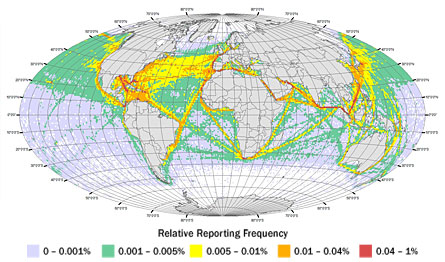Emissions from oceangoing ships substantially boost acid rain on shore and may account for more than a quarter of the ground-level ozone in some coastal areas, a new study reveals.

Many commercial vessels, especially long-haul cargo ships, spend much of their time in international waters. Nevertheless, exhaust from these ships contributes to onshore pollution: Studies have shown that about 70 percent of shipping occurs within 400 kilometers of land.
To assess the amount of pollution spewed by ships, as well as pinpoint where those emissions occur, Stig Dalsøren, an atmospheric scientist at the University of Oslo in Norway, and his colleagues analyzed data gathered worldwide during 2004.
In 2004, the world’s merchant fleet included almost 91,000 ships that each weigh at least 100,000 tons, Dalsøren says. To tally the emissions from those vessels, the team divided the ships into 15 categories — everything from tugboats and trawlers to cruise ships and supertankers — subdivided each category into seven weight ranges, and then estimated the emissions that each type of ship would produce while cruising at sea or while idling in port. Then, the researchers used information about the routes sailed by about 32,000 ships during 2004, including time spent in port, to determine where emissions were produced. The team reported its findings online March 24 in Atmospheric Chemistry and Physics.
Together, ships worldwide burned about 217 million metric tons of fuel in 2004, about 5 percent of which was consumed while in port, Dalsøren says. Because much of that fuel was sulfur-rich diesel, emissions included more than 16 million tons of sulfur dioxide. That gas, plus the various nitrogen oxides, or NOx, gases in the engine exhaust, reacts with moisture in the air to produce acid rain. Worldwide, ships account for about 11 percent of the acid rain due to NOx emissions and about 4.5 percent of the acid rain due to sulfur dioxide emissions, the team estimates. In Singapore, the world’s most visited port, about 15 percent of the sulfur dioxide in the air comes from ships. In some coastal areas with little industrial activity but a lot of ships passing nearby, such as the northwestern coasts of North America and Scandinavia, as much as half of the acid rain there may stem from ship emissions.
Ships are also responsible for considerable amounts of ground-level ozone, which is produced when sunlight stimulates chemical reactions in emissions-rich air. In some parts of western Europe, between 5 and 15 percent of the ground-level ozone comes from ship emissions. In some areas of western North America, as much as 25 percent of that pollutant can be traced back to ships, Dalsøren says.
The new findings reveal “the important influence of ship emissions on air quality in busy ports,” says David Stevenson, an atmospheric scientist at the University of Edinburgh in Scotland. The research also suggests that the largest sources of emissions are container ships, the vessels most responsible for carrying large volumes of consumer goods on transoceanic routes. As land-based sources of pollutants become more regulated, pollutants in the exhaust from ships will make up a growing proportion of anthropogenic emissions.
“What’s really cool about this study is that the results are converging” with data now being compiled by the International Maritime Organization, says James Corbett, a marine policy analyst at the University of Delaware in Newark. The London-based IMO, an agency within the United Nations, is responsible for improving maritime safety and preventing pollution from ships, Corbett notes. The new findings will enable scientists and policymakers to better estimate the effects of proposed regulations on various types of ships, he adds.






